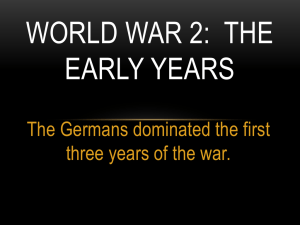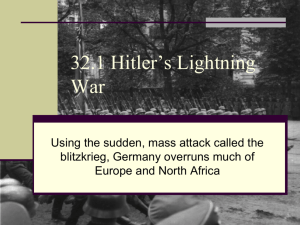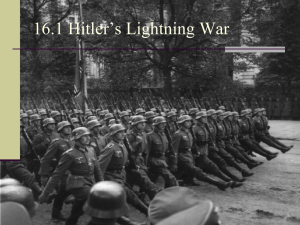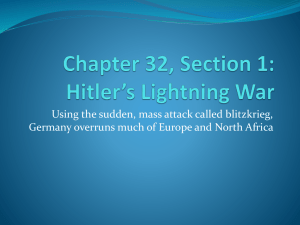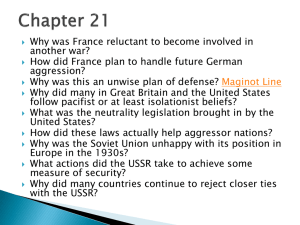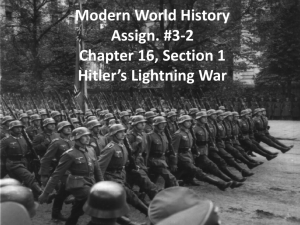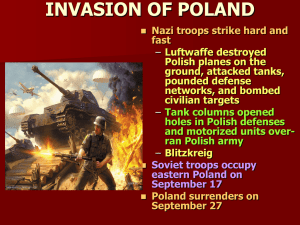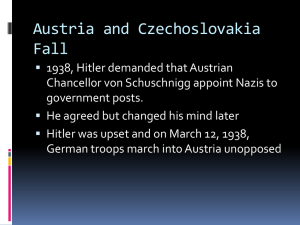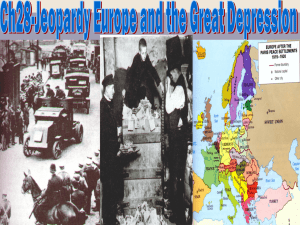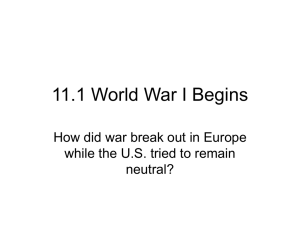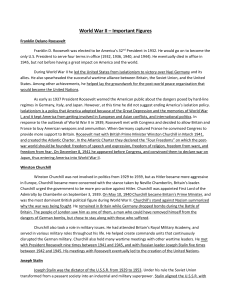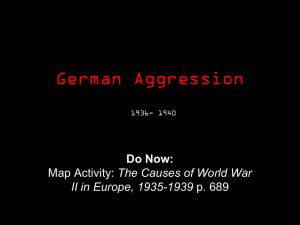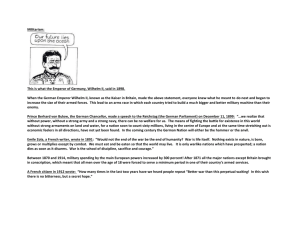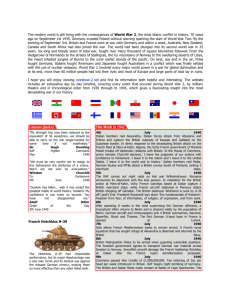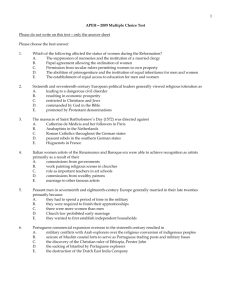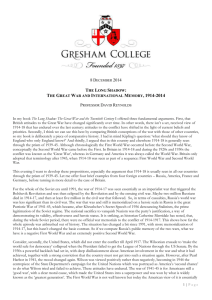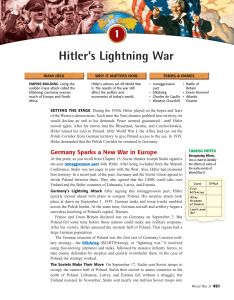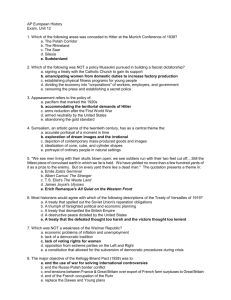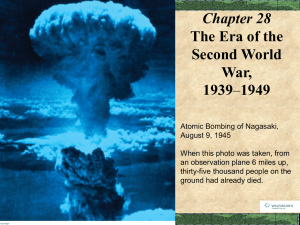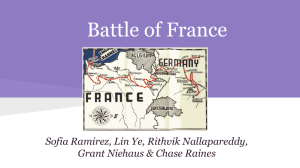World War II Begins Standards 10.8.3, 10.8.4, 10.8.6 Germany
advertisement
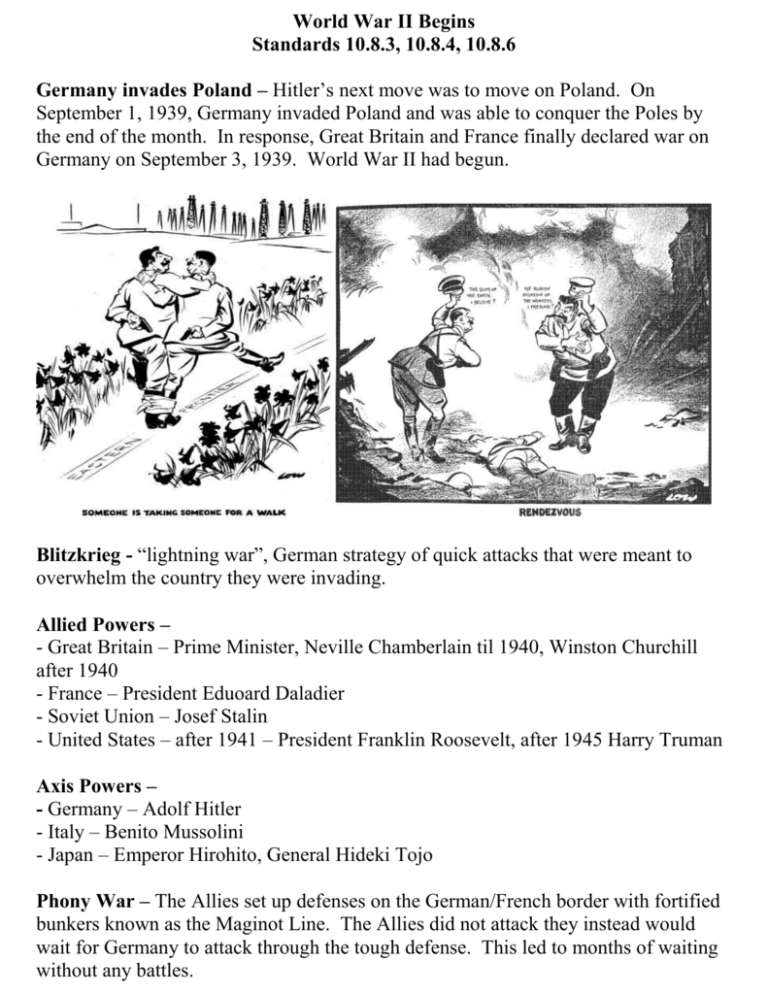
World War II Begins Standards 10.8.3, 10.8.4, 10.8.6 Germany invades Poland – Hitler’s next move was to move on Poland. On September 1, 1939, Germany invaded Poland and was able to conquer the Poles by the end of the month. In response, Great Britain and France finally declared war on Germany on September 3, 1939. World War II had begun. Blitzkrieg - “lightning war”, German strategy of quick attacks that were meant to overwhelm the country they were invading. Allied Powers – - Great Britain – Prime Minister, Neville Chamberlain til 1940, Winston Churchill after 1940 - France – President Eduoard Daladier - Soviet Union – Josef Stalin - United States – after 1941 – President Franklin Roosevelt, after 1945 Harry Truman Axis Powers – - Germany – Adolf Hitler - Italy – Benito Mussolini - Japan – Emperor Hirohito, General Hideki Tojo Phony War – The Allies set up defenses on the German/French border with fortified bunkers known as the Maginot Line. The Allies did not attack they instead would wait for Germany to attack through the tough defense. This led to months of waiting without any battles. Norway and Denmark Fall – Hitler ended the phony war in April 1940 by conquering Norway and Denmark, to gain access to the North Sea and Atlantic. The Netherlands and Belgium Fall – In May 1940, Germany moved toward France in capturing the Netherlands and soon defeated Allied forces in Belguim. Germany Attacks France - With France well fortified on the Maginot Line, German troops went through the Belgian-French border which was covered by the thick Ardennes Forest. By using this plan, they were able to completely bypass the Maginot Line and surprise the French forces from behind. Rescue At Dunkirk – The Germans pushed French forces to the Northern port city of Dunkirk with the English Channel at their backs. There the British pulled off a daring rescue of any ship (Royal Navy Ships to yachts and fishing boats) to pull the 338,000 French soldiers to safety in England against heavy German bombing. The rescue took place from May 26 to June 4 1940. France Falls – With the French forces in Britain, Germany easily conquered the rest of the country. France surrendered on June 22, 1940. Germany put Northern France under military occupation and set up a puppet government in Southern France under Marshal Phillippe Petain named Vichy France. Free French Military Forces – General Charles De Gaulle continued to lead French troops in England with the goal of liberating the country from German control. Churchill Becomes Prime Minister – Winston Churchill became the new Prime Minister replacing Neville Chamberlain. Churchill would become the voice of the British people to give the country hope as they faced the Axis powers alone at this point. Battle of Britain – Germany did not attempt to invade England. Instead, they used their airforce, the German Luftwaffe, to continuously bomb cities such as London to terrify the public and force Britain out of the war. The Battle of Britain lasted from September 7 until Germany gave up on May 10, 1941. Britain’s Technology – 2 technological developments gave the British the advantage during the Battle of Britain and the rest of WWII. Radar allowed the British to detect German Luftwaffe attacks en route. Also, the British were able to steal a German “Enigma” machine that sent coded messages. The British used it to decipher the German code and launch surprise attacks. Fighting in North Africa – During the Battle of Britain, Italy sent forces to invade British controlled Egypt. The Axis wanted to control the flow of oil from the Middle East through the Suez Canal. Italy made early gains but Britain was able to counterstrike against them decimating Italian forces. Germany sent forces under Erwin Rommel, “The Desert Fox”, to reinforce the Italians. Rommel was one of the most successful and cunning German Generals. War in the Balkans – During Rommel’s campaign in North Africa, German forces moved to seize the Balkan countries in early 1941 to set up his ultimate attack against the Soviet Union. By April 1941, Germany controlled the entire Balkan region. Operation Barbarossa – On June 22, 1941, Hitler became greedy with his conquests in Europe and broke the Non-Aggression Pact he had with Stalin and the Soviet Union. This brought the Soviet Union into WWII on the side of the Allies. The Germans were able to penetrate 500 miles inside the Soviet Union quickly using the Blitzkrieg strategy. The Soviets, meanwhile, used the same scorched-earth technique they used against Napoleon to cut off German food. Siege of Leningrad – German forces cut the city of Leningrad off from the rest of the Soviet Union to force a surrender of the city. They bombed food warehouses and did not allow any food to enter the city. Nearly 1 million citizens died because of starvation, but the city did not surrender. Germany moved on the capital city of Moscow, but was deterred by the harsh cold winter over 1941-1942. The Atlantic Charter – U.S. President Franklin Roosevelt attempted to move the country away from isolationism and to strengthen ties with the Allies. The Neutrality Acts was changed to the Lend-Lease Act where the U.S. could lend weapons to Great Britain. The Atlantic Charter was agreed upon in 1941 to have shared goals in opposing the aggression of the Axis Powers. Japan joins the War – Japan, seeking expansion into mainland Asia, joined the Axis Powers in September 1940 with Germany and Italy. Japan took control of French Indochina and continued its war with China. The U.S. responded to cutting of Japan economically from resources like oil. Discussion Questions – Talk and Write Down All Answers 1. What do the first political cartoons suggest about the relationship between Stalin and Hitler and their Non-aggression pact? Explain. 2. What has been different about fighting in World War II than in World War I? Explain. 3. What occurrences have we learned about that are going to lead the United States into the war? Explain.
